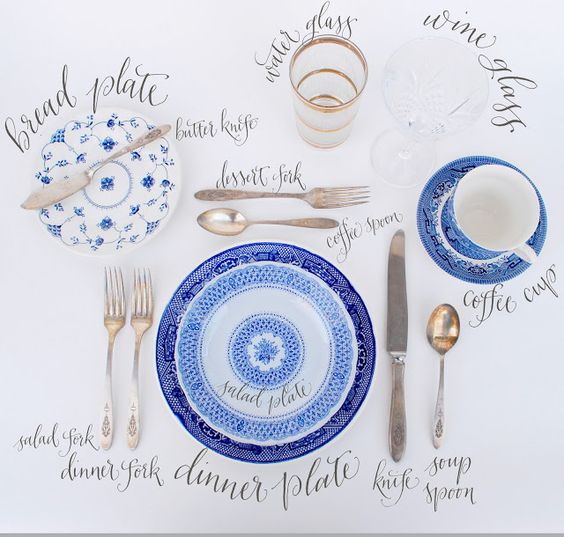A tavola con stile: il bon ton non passa mai di moda - At table with style: bon ton never goes out of fashion
Ognuno di noi ha avuto o avrà nella vita qualche occasione speciale da organizzare o a cui prender parte: che si tratti di un matrimonio o semplicemente di una cena a casa, ricordiamoci che le buone maniere e il galateo non passano mai di moda!
Ho pensato a un piccolo vademecum per avere sempre la situazione "sotto controllo". Quali sono gli errori da non fare, come essere sicuri della qualità del servizio, come distinguersi per buon gusto e per educazione.
MISE EN PLACE
Iniziamo con la tavola. La prima impressione è quella che conta. Come valutare una corretta mise en place? Di seguito due immagini per aiutarci ad apparecchiare nel modo corretto, anche quando siamo a casa. Le buone maniere iniziano proprio dalla nostra tavola quotidiana. Perchè rinunciare a curare prima di tutto casa nostra e i nostri pasti? Allora non siate frettolosi! Armatevi di santa pazienza e godete di ogni pasto conversando con chi vi sta accanto e ritrovando il piacere della convivialità.
We all have or will have some special occasion in life to organize or attend: whether it's a wedding or just a dinner at home, let's remember that good manners never go out of fashion!
.............................................................................................................................................................................................................
I’ve thought of a small checklist to keep the situation under control. Which are the main mistakes made, how to be sure of the quality of service, how to stand out for good taste and education.
MISE EN PLACE
Let's start with the table. The first impression is what counts. How to evaluate a correct setting? Here are two images to help us lay a table correctly, even when we're at home. Good manners start right from our daily table. Why should we renounce to these at home and for our own daily meals? So don’t be hasty! Let’s be patient and enjoy every meal by talking to those around us, rediscovering the pleasure of conviviality.
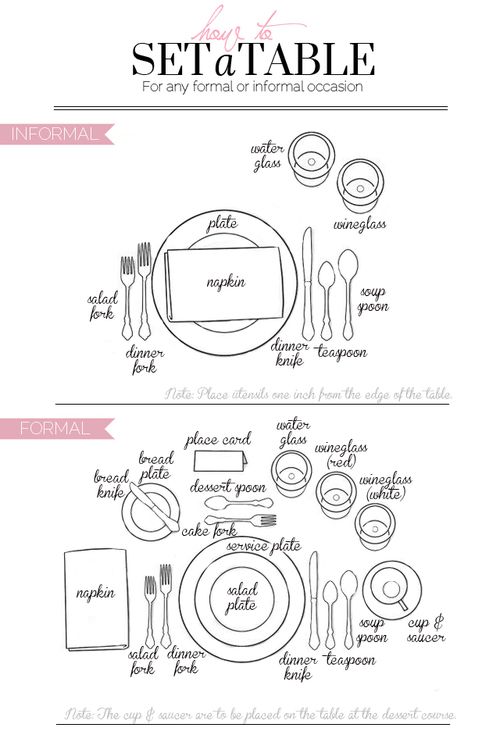
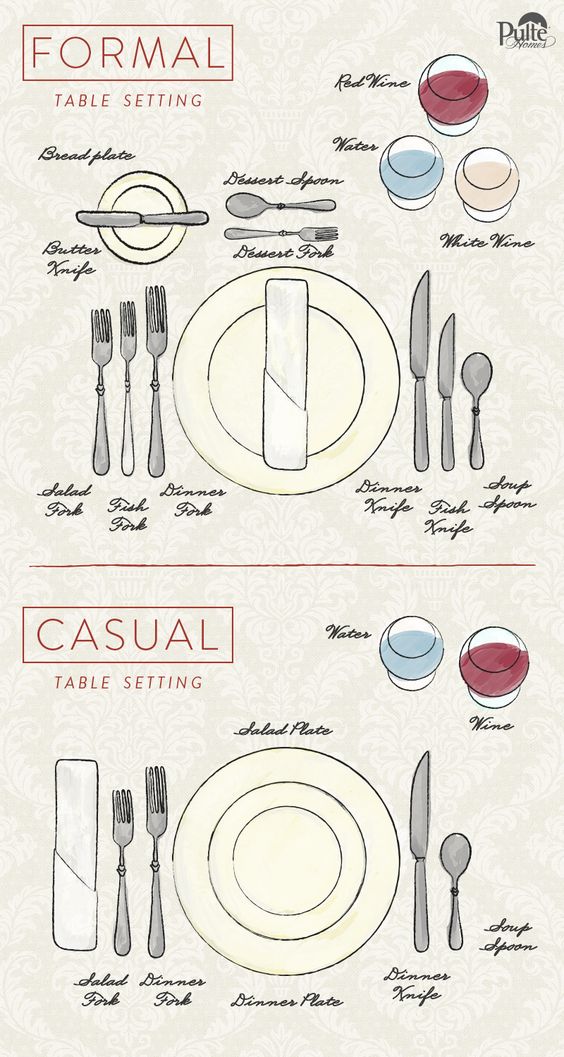
Molto importante, nei tavoli formali e non, è la gestione dello spazio. Non è piacevole mangiare gomito a gomito con chi si ha accanto o non avere lo spazio per alzarsi. Bisogna sempre guardare che una sala abbia lo spazio sufficiente per accogliere i nostri invitati, siate critici e non fidatevi sempre di quello che vi viene detto. Alcune regole base vi possono aiutare in questo.
Se utilizzate tavoli tondi, potete considerare quanto segue:
- tavolo tondo 1,20 mt = 6 persone
- tavolo tondo 1,40 mt = 8 persone
- tavolo tondo 1,80 mt = 10 persone
Non cercate di fare entrare in un tavolo più persone di queste. Considerate che ogni persona avrà bisogno di circa 50 cm per stare comoda. Fra un tavolo e l'altro 140 cm sono lo spazio sufficiente per consentire il passaggio dei camerieri e lo spostamento degli ospiti.
POSATE "MESSAGGERE"
Cosa stanno a significare le posizioni delle posate? A seconda di come vengono messe nel piatto indicano qualcosa di preciso:
1) volontà di fermarsi
2) pronti alla prossima portata
3) buonissimo!
4) finito
5) non ho gradito
..............................................................................................................................................................................................................
Space management is very important, both in formal and informal tables. It is not pleasant to eat elbow tight with someone next to you or not to have space to get up. Always check that a room has enough space to accommodate our guests, be critical and do not always trust what you’re told. Some basic rules can help you in this.
If you use round tables, you can consider the following:
Round table 1.2 mt diameter = 6 people
Round table 1.4 mt = 8 people
Round table 1.8 mt = 10 people
Do not try to get more people into the table. Consider that each person will need about 50 cm to be comfortable. Between a table and the other 140 cm are enough space to allow the waiters to pass and the guests to move.
CUTLERY MESSAGES
What do the messages left by cutlery mean? Depending on how these are left in the dish, they have specific meanings
1) desire to stop
2) ready for the next course
3) very good!
4) finished
5) I did not like it
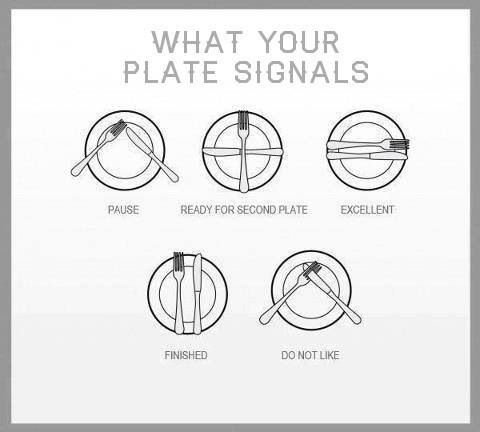
COME DISPORRE I COMMENSALI
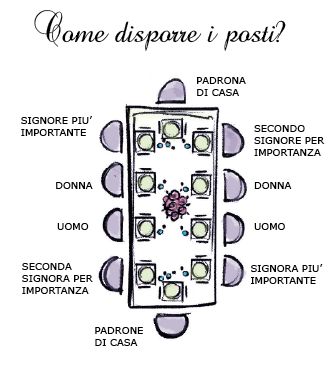
Passiamo ora a qualche nozione sui tipi di servizio, per capire quale scegliere in base a ogni situazione.
TIPI DI SERVIZIO
1) ALL'INGLESE il cameriere serve il cliente da sinistra direttamente dal vassoio
2) ALL'ITALIANA le pietanze sono già impiattate e si serve da destra
3) ALLA FRANCESE il cameriere porge il vassoio al cliente e il cliente di serve da solo. Molto elegante, usato specialmente in cene di rappresentanza o private.
4) ALLA RUSSA è il servizio più lussuoso ed elegante. Si utilizzano sempre i vassoi, spesso con un carrello d'appoggio, e lo chef fornisce spiegazioni sui piatti e interagisce con i commensali.
MAI E POI MAI
Stiamo attenti a non dimenticarci:
- giù i gomiti dalla tavola
- la bocca chiusa mentre mastichiamo
- non iniziare a mangiare, se tutti non sono stati serviti
- non passiamo davanti agli altri per prendere le cose
- seduti dritti e composti
- MAI il telefono a tavola
- per favore, grazie, permesso
- non urlare
- non alzarsi durante le portate, se proprio necessario aspettiamo lo stop fra una portata e l'altra
E adesso tutti a tavola!
..............................................................................................................................................................................................................
Now let's go over some different types of service to figure out which one to choose in any situation.
TYPES OF SERVICE
1) ENGLISH the waiter serves guests from the left directly from the tray
2) ITALIAN dishes are presented already served, from the right
3) FRENCH the waiter provides a tray to guests who serves himself. Very elegant, especially used in dinners or private dinners.
4) RUSSIAN is the most luxurious and elegant service. Trays are always used, often with a supporting trolley, and the chef provides explanations on the dishes and interacts with the diners.
NEVER EVER
Be careful not to forget:
- Keep your elbows off the table
- Chew with your mouth closed
- Do not start eating, if all have not been served yet
- Do not pass in front of others to take things
- Seat up straight
- NEVER phone at the table
- Please, thank you, excuse me
- No loud talking
- Do not get up during courses, if one really needs to, wait for a pause between courses
And now all to table!
Claudia
email : info@cg-eventdesign.it

